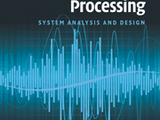Digital Signal Processing: System Analysis and Design
Version 1.0.0 (17.9 MB) by
Paulo S. R. Diniz
The book covers all the major topics of digital signal processing (DSP) design and analysis in a single cover.
When we hear the word “signal” we may first think of a phenomenon that occurs continuously over time that carries some information. Most phenomena observed in nature are continuous in time, such as for instance our speech or heart beating, the temperature of the city where we live, the car speed during a given trip, the altitude of the airplane we are traveling in –these are typical continuous-time signals. Engineers are always devising ways to design systems, which are in principle continuous time, for measuring and interfering with these and other phenomena. One should note that, although continuous-time signals pervade our daily lives, there are also several signals which are originally discrete time; for example, the stock-market weekly financial indicators, the maximum and minimum daily temperatures in our cities, and the average lap speed of a racing car. If an electrical or computer engineer has the task of designing systems to interact with natural phenomena, their first impulse is to convert some quantities from nature into electric signals through a transducer. Electric signals, which are represented by voltages or currents, have a continuous-time representation. Since digital technology constitutes an extremely powerful tool for information processing, it is natural to think of processing the electric signals generated using it. However, continuous-time signals cannot be processed using computer technology (digital machines), which are especially suited to deal with sequential computation involving numbers. Fortunately, this fact does not prevent the use of digital integrated circuits (which is the technology behind the computer technology revolution we witness today) in signal processing systems designs. This is because many signals taken from nature can be fully represented by their sampled versions, where the sampled signals coincide with the original continuous-time signals at some instants in time. If we know how fast the important information changes, then we can always sample and convert continuous-time information into discrete-time information which, in turn, can be converted into a sequence of numbers and transferred to a digital machine. The main advantages of digital systems relative to analog systems are high reliability, suitability for modifying the system’s characteristics, and low cost. These advantages motivated the digital implementation of many signal processing systems which used to be implemented with analog circuit technology. In addition, a number of new applications became viable once the very large scale integration (VLSI) technology was available. Usually in the VLSI implementation of a digital signal processing system the concern is to reduce power consumption and/or area, or to increase the circuit’s speed in order to meet the demands of high-throughput applications.
Currently, a single digital integrated circuit may contain millions of logic gates operating at very high speeds, allowing very fast digital processors to be built at a reasonable cost. This technological development opened avenues to the introduction of powerful generalpurpose computers which can be used to design and implement digital signal processing systems. In addition, it allowed the design of microprocessors with special features for signal processing, namely the digital signal processors (DSPs). As a consequence, there are several tools available to implement very complex digital signal processing systems. In practice, a digital signal processing system is implemented either by software on a generalpurpose digital computer or DSP, or by using application-specific hardware, usually in the form of an integrated circuit.
For more details visit:
http://www02.smt.ufrj.br/~diniz/digitalbook2/
Cite As
Paulo S. R. Diniz (2024). Digital Signal Processing: System Analysis and Design (https://www.mathworks.com/matlabcentral/fileexchange/104555-digital-signal-processing-system-analysis-and-design), MATLAB Central File Exchange. Retrieved .
MATLAB Release Compatibility
Created with
R2021b
Compatible with any release
Platform Compatibility
Windows macOS LinuxTags
Community Treasure Hunt
Find the treasures in MATLAB Central and discover how the community can help you!
Start Hunting!Discover Live Editor
Create scripts with code, output, and formatted text in a single executable document.
matlab/Chapter0
matlab/Chapter0pds
matlab/Chapter1/Examples
matlab/Chapter1/Exercises
matlab/Chapter1/Experiments
matlab/Chapter10pds
matlab/Chapter11pds
matlab/Chapter12pds
matlab/Chapter13pds
matlab/Chapter1pds/Examples
matlab/Chapter1pds/Exercises
matlab/Chapter1pds/Experiments
matlab/Chapter2/Examples
matlab/Chapter2/Exercises
matlab/Chapter2/Experiments
matlab/Chapter2pds/Examples
matlab/Chapter2pds/Exercises
matlab/Chapter2pds/Experiments
matlab/Chapter3/Examples
matlab/Chapter3/Exercises
matlab/Chapter3/Experiments
matlab/Chapter3pds/Examples
matlab/Chapter3pds/Exercises
matlab/Chapter3pds/Experiments
matlab/Chapter4/Exercises
matlab/Chapter4/Experiments
matlab/Chapter4pds/Exercises
matlab/Chapter4pds/Experiments
matlab/Chapter5/Exercises
matlab/Chapter5/Experiments
matlab/Chapter5pds/Exercises
matlab/Chapter5pds/Experiments
matlab/Chapter6/Experiments
matlab/Chapter6/Experiments/Trash
matlab/Chapter6pds/Experiments
matlab/Chapter7pds
matlab/Chapter8pds
matlab/Chapter9pds
matlab/Chapter9pds/experiment9.2
| Version | Published | Release Notes | |
|---|---|---|---|
| 1.0.0 |

